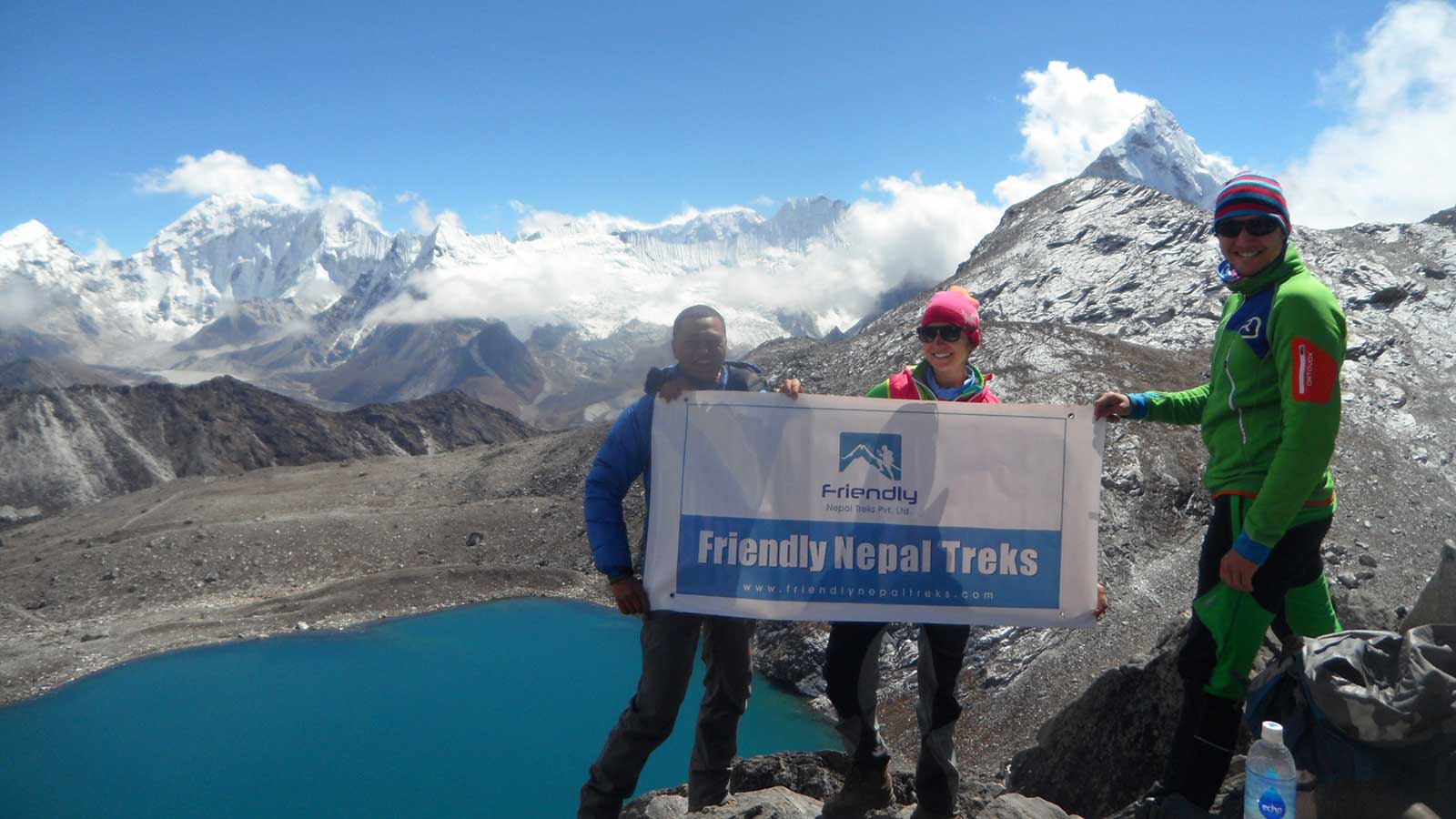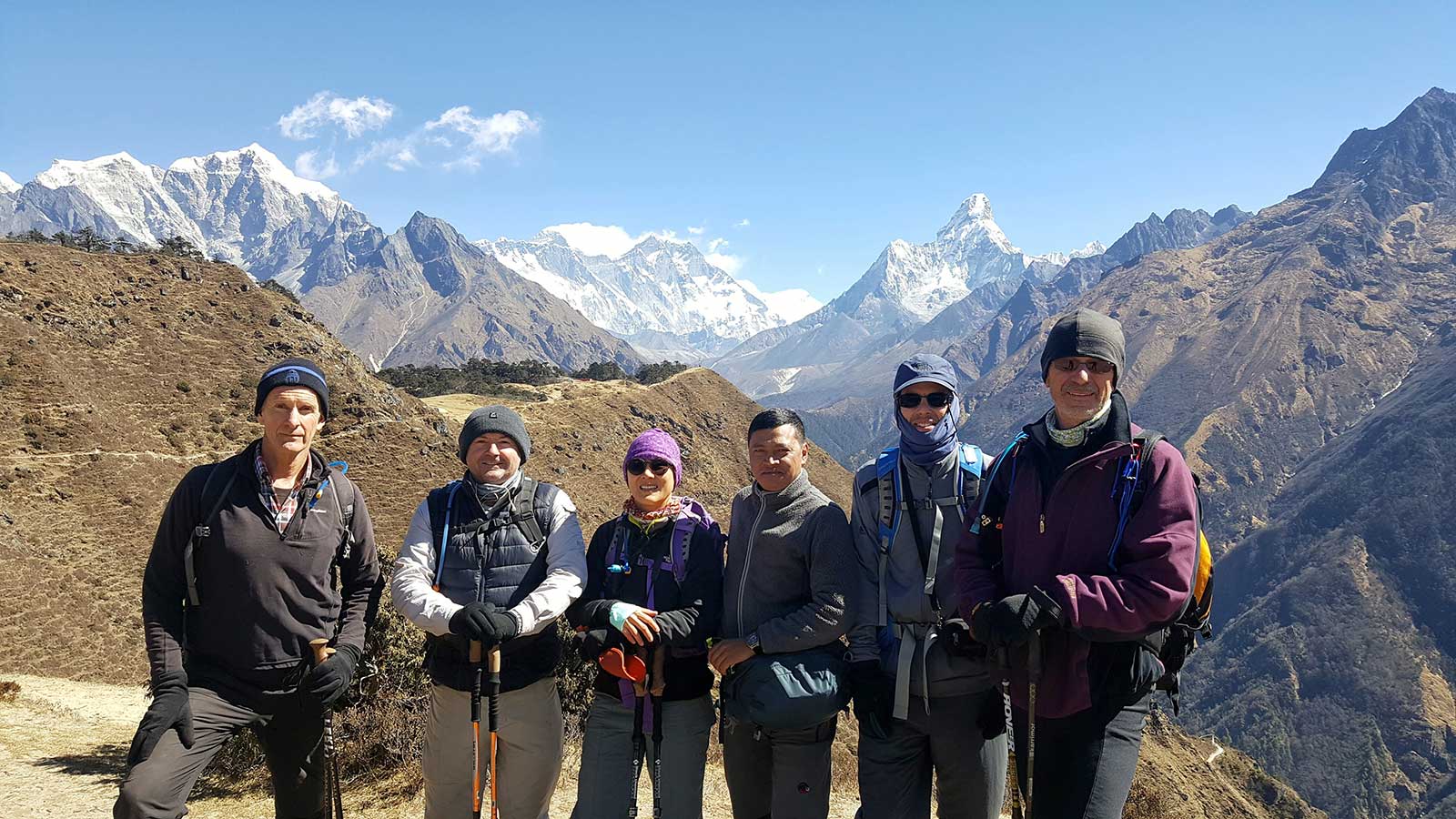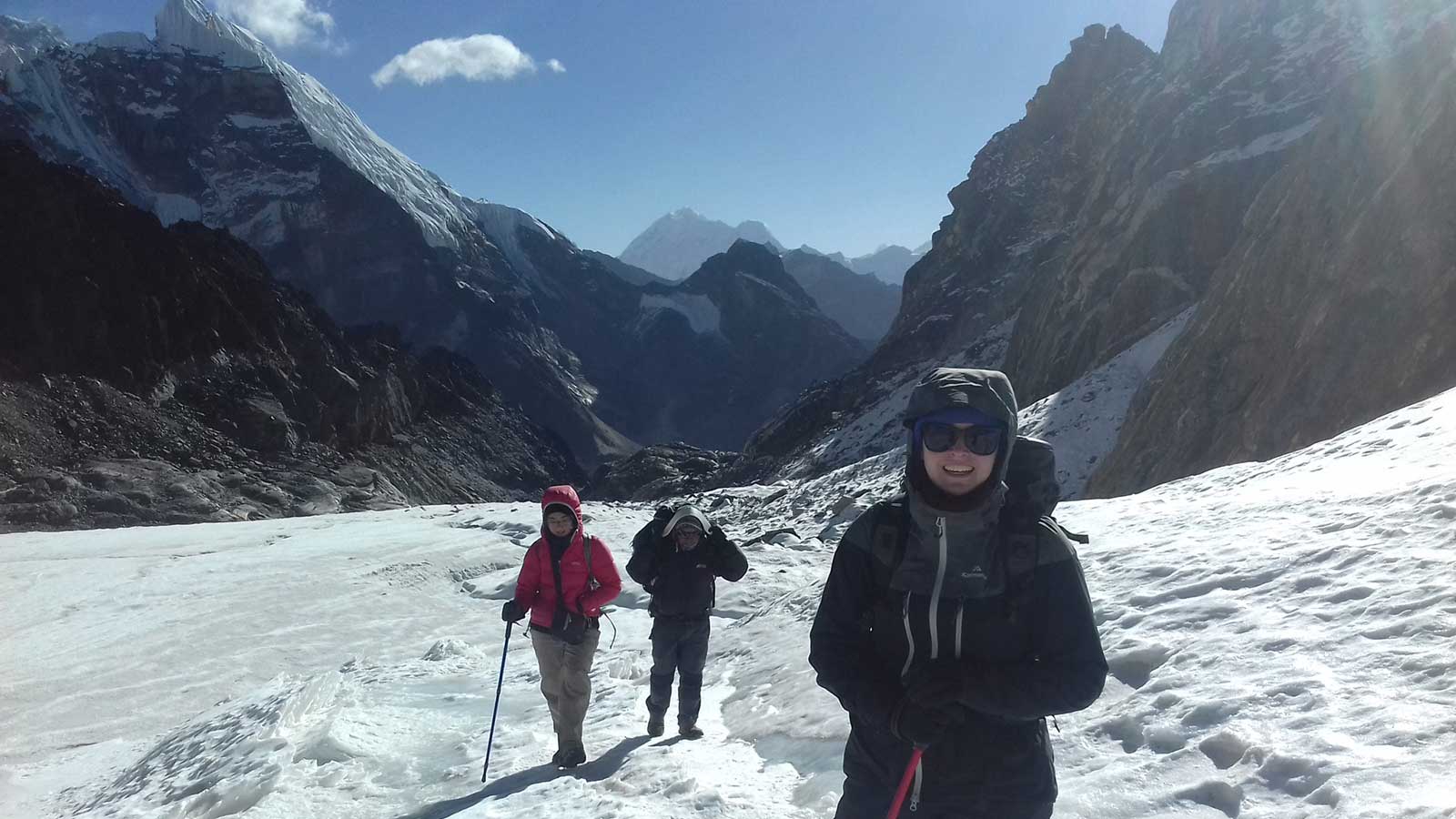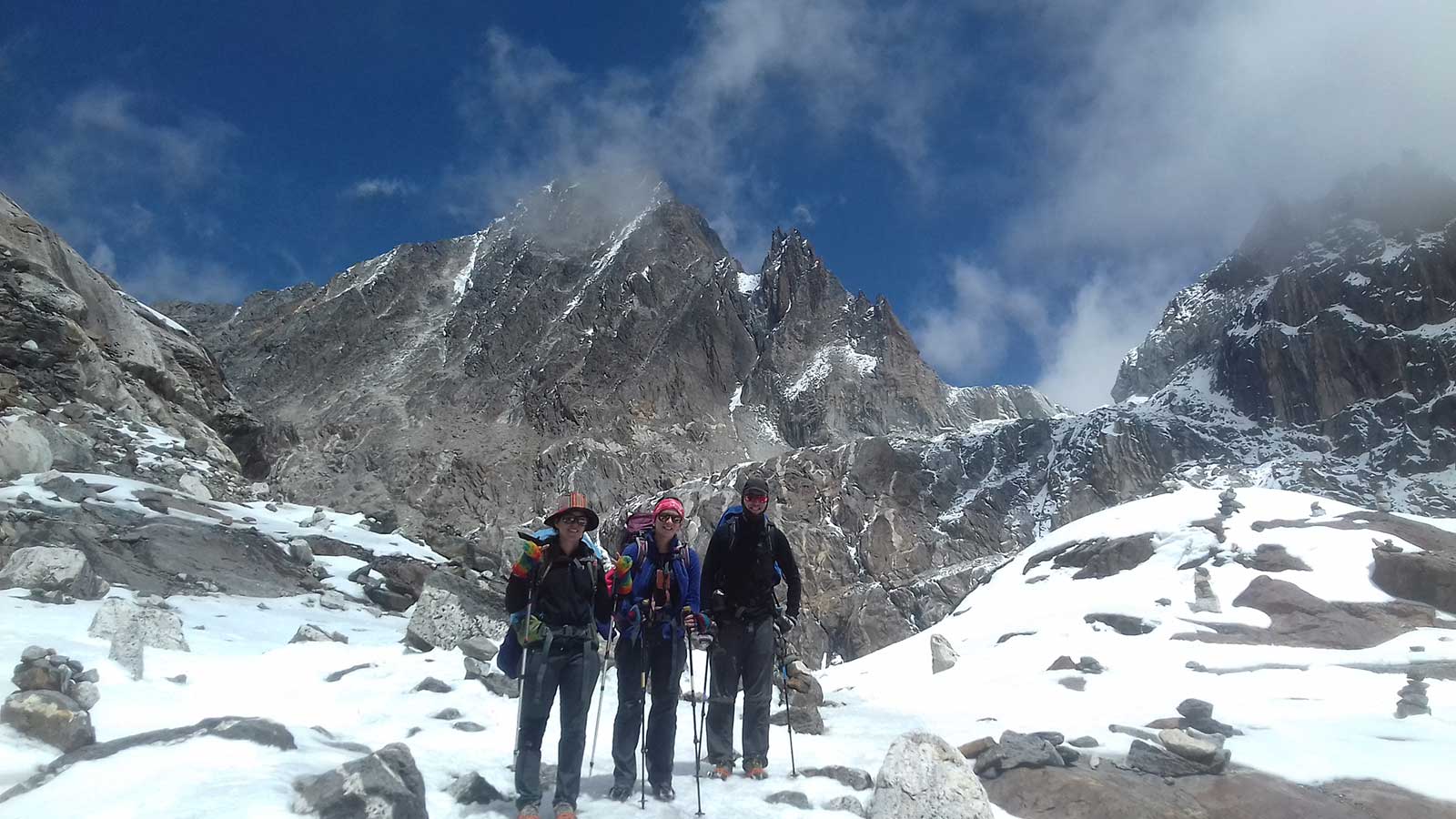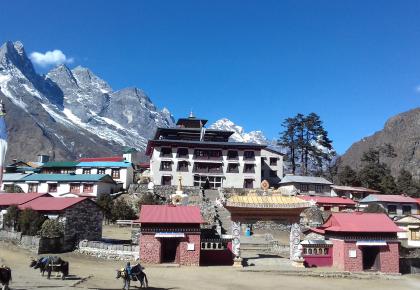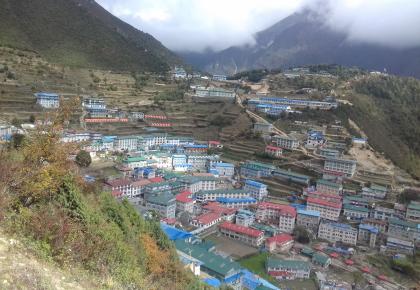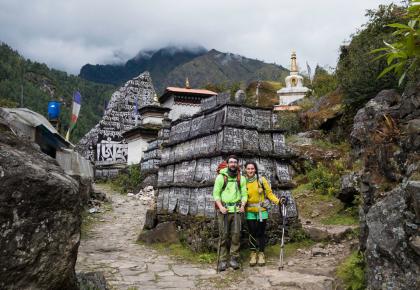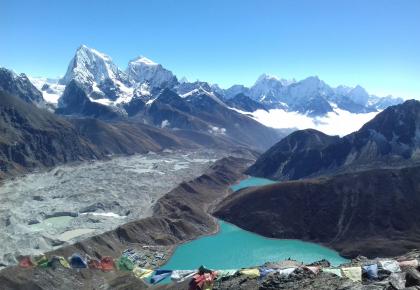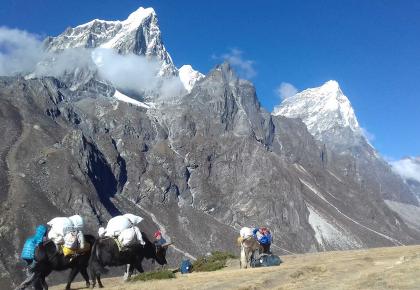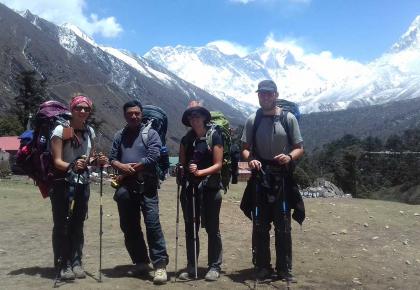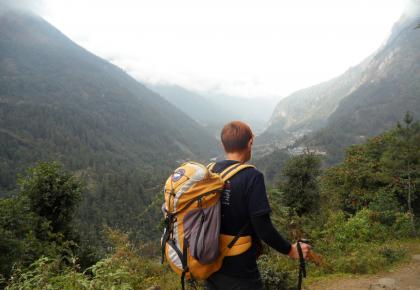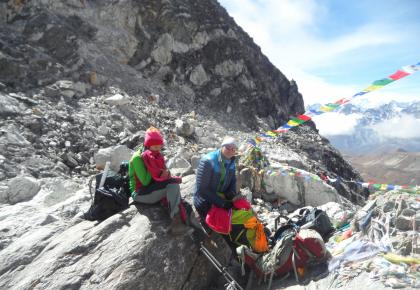Three High Passes Trek via Sallery
-
28 Days
Duration
-
5570m
Max Altitude
-
Strenuous
Trip Grade
-
2-14
Group Size
-
SEP to DEC & March to MAY
Best Season
Trip Highlight
- Oppertunities to involve the respected Sherpa lifestyles in Khumbu Valley.
- Surrounded by charming mountain views from start to End from Namche.
- Impressive hike along the Dudha Koshi and Imza rivers along the Imza ricer.
- Observe the highland Sherpa culture with their tradditional local life practically..
- Glances of the picturesque mountains from start to end with veritie of landscopes.
- Lovely mighty Everest view from the Everest View Lodge and Tengboche manastery.
- Eye-catching Thamaserku, Ama Dablam, Lhoste, Cho Yu, and Islang peak views.
- Amazing Mt. Everest towering from Base camp keeping loste left and Nupsre right side.
- Breath-taking Kumbu glacier along the Khumbu Valley draing with natural rivar sound.
- Sightseeing in twin villages Khumjung and Khunde through the Everest view hotel.
- Chance to see impressive Buddhist monasteries and observe the inside the manastery..
Trip Overview
“If you can’t find a path with no obstacles, it probably doesn’t lead anywhere.”
Everest Three Pass Trek is an adventurous and electrifying trek in the Everest region of Nepal which offers refreshing experiences and dramatic views throughout the entire trek. Trekking on one of the most popular trekking trails, this adventurous trek involves ascend and descend in several rough and rocky terrains which is perfect for trekkers who wish to experience some breathtaking challenges during their trek.
Major highlights of our trek include the ascend to the Gokyo Peak, Chhukung Ri and the challenging Renjo La pass (5,360m), Cho La Pass (5,368m) and Kongma La Pass (5,535m) while getting up & close to the world’s tallest mountain peak, Mount Everest with a panoramic view of the picturesque Himalayas from the iconic Kala Patthar. And get immersed in the pleasant environment of Gokyo valley accompanied by several turquoise blue alpine lakes, majestic glaciers in the valley. This trek needs trekkers to have above average physical fitness with positive attitude and mental strength along with ability to adapt to the remote environment. Come to Nepal and join this trek to experience the true beauty of the mighty Himalayas!
Overview Itinerary
Day 01: Arrival-Pick up from Nepal airport and transfer to your hotel
Day 02: Trek preparation and some sight seen in KTM
Day 03: KTM to Salleri by Jeep -9hours
Day 04: Salleri to Junbesnsi-5hours
Day 05: Junbensi to walk to Monastaries-4hours
Day 06: Junbensi to Nunthala-7hours
Day 07: Nunthala to Buspa-6-7hours
Day 08: Buspa to Chaurikharka-7hours
Day 09: Chaurikharka to Manzo 2900M-6hours
Day 10: Manzo to Namche 3400-4hours
Day 11: Namche-Acclimatise day/Hiking around the Panaroma views of Mt Everest
Day 12: Namche to Pangboche 3900M-7hours
Day 13: Pangboche to Amadablam BC 4600M to Pangboche 3900M-6hours
Day 14: Pangboche to Dingboche 4300M-4:30hours
Day 15: Dingboche-Acclimatise day /Nakarjung peak 5100M- and Dingboche 4300M-6hours
Day 16: Dingboche to Chhukum4700M-4hours
Day 17: Chhukum to Chhukum Ri 5500m to Chhukum 4700M-6hours
Day 18: Chhukum to Khongmo La pass 5600M to LAbuche 4900M-8-9hours
Day 19: Labuche to Grepshep 5160M to Everest BC 5380M and Gorepshep 5160M
Day 20: Gorepshep-early morning hike to Kalla patter 5500M and Jungla 4700M-7hours
Day 21: Jung La to Chola pass 5400M to Dragnag-4800M-7hours
Day 22: Dragnag to Gokyo 4750M-3hours
Day 23: Gokyo to Gogyo Ri 5370M to Gokyo
Day 24: Gokyo to Renjo La pass 5380M to Lungden 4450M-8hours
Day 25: Lungden to Namche 3440M-6:30hours
Day 26: Namche to Lukla 2800M-7hours
Day 27: Lukla to fly back to KTM 1300M-35minute flight
Day 28: Fly back to your home or others activities
Day to Day Itinerary
From the moment you enter Nepal, your adventure begins as stepping into Nepal brings along a bundle of surprises. There are rituals you have never seen, there are festivals that never end, and there are languages that you will never become familiar with. Indeed, passing through the streets of such a diverse land is adventurous.
Upon your arrival, one of us will be there to pick you up from the airport who will accompany you to your hotel. Your trekking guide will meet you in the evening and explain all the necessary details about the trip. With your guide, you may consult whatever queries you have on that day itself.
Today, we will be walking across the historical streets of Kathmandu to witness some legendary mansions of the medieval period. There are countless such ancient temples and monasteries with 3 massive durbar square (palaces) masterpieces dominating the skyline of the three major cities- Kathmandu, Lalitpur, and Bhaktapur- inside the Kathmandu valley.
On this day, we will be able to explore only four of these sites- Patan Durbar Square( 12th century palace built in a typical Newari style architecture with remarkable window carvings and stone sculptures), Swayambhunath (a Buddhist pilgrimage site with a massive 13th-century spherical stupa), Boudhanath Stupa (14th century spherical stupa with a massive mandala at the center- one of the largest unique structure stupas in the world), and Pashupatinath Temple (8th century Hindu pilgrimage site dedicated to Lord Shiva with over 500 shrines- each with a Shiva Lingam- dotted around the premises of the temple).
To reach the Everest region from Kathmandu, there are two options to choose from- either via flight (Lukla) or via the road (Salleri). By road, it takes around 9 hours to finally arrive at the Salleri along the winding hilly streets of Nepal. This medium of travel will cost you both time and money, but the reminiscing views of the mountains and traditional villages are worth every penny. Once you arrive at your destination, it must have started getting dark. So, stay at one of the lodges at Salleri for the night.
Salleri to Junbensi is a pleasant walk along the older Everest trails, which were explored by the legendary Edmund Hillary and his team long long ago. The path passes through the forests, bridges, ridges, and several waterbodies before entering into the hamlet of Junbensi. One noticeable aspect of these forests is that they appear quite denser than what is found in the high altitudes. Overall, this journey to Junbensi is amazingly exciting and wonderful.
The monasteries around Northern Nepal are inspired by the Himalayas. Therefore, exploring the mountains without visiting the monasteries can ruin the dream of getting authentic mountain experiences in the Himalayas. So, on this day, we will manage to stumble across the beauty of those monasteries. Plus, with the help of the local people, we will learn about its history and dogmas that will make our expedition a meaningful one. Junbensi Monastery, Bodhi Stupa are few of the many places that we will be going to on this day.
The walk to Nunthala from Junbensi is relatively long but an interesting walk. We walk up and down along the wavering switchbacks to finally arrive at the Nunthala. The lush farm fields, fencing the trail, create a welcoming atmosphere for a perfect walk. Upon reaching the Nunthala, we will find a lodge and rest our backpack there. After that, we will talk to the local people and learn about their culture. It is really an amazing experience.
While Nunthala to Buspa takes 6-7 hours, this journey can be more exhausting as the long hour walks of previous days might add more pressure on the knees. However, this is not the case for every trekker. Once you arrive at Buspa, take a short walk along the village. The indigenous inhabitants of this village are very much hospitable. You might be invited to join some family feast, or festivals (if on the right time).
The more we walk, the closer we arrive at the Everest. From Buspa, Chaurikharka is 7 hours away by foot. Seeing the map, it doesn’t feel like we have to travel a long way. However, the zigzag and rocky path slows you down to take a short step. Plus, as you climb higher, the altitude keeps on pushing. Upon arriving at Chaurikharka, escape into the rural communities to witness the country-kids and other people enjoy nature.
From Chaurikharka, Monjo is just a couple of Kilometers away, and it doesn’t take a lot of time to reach there. The trails from Monjo are the classic routes followed by the trekkers and porters, enrolling in the Everest. It is completely off-the-beaten-track, where barely can you see a person walking. It is because most of the trekkers prefer to catch a flight to Lukla rather than going along the long trail.
From Monjo, the Namche is not very far away. The trail climbs steadily from the Monjo until arriving at the entrance point of the Sagarmatha National Park. After checking in the permit, we will ascend gradually through the forest and cross the hamlet of Jorsale along the ascending road to Namche. Once we come out of the woods, the view of Namche dazzles in your eyes. It is the vibrant prayer flags of Namche that appears startling from the distance. A beautiful Kani Gate welcomes us to the ancient village of Namche.
During the high-altitude trekking, the acclimatization becomes absolutely necessary so as to avoid any complications related to the altitude on going further up the trail. For that purpose, Namche is a geographically perfect spot. In contrast to other regions around the Everest, Namche receives most of the sunlight. So, it is relatively warm. Plus, a number of side trips dissociate from Namche that makes it an ideal point for acclimatization.
Today, we will hike either to Khumjung and Khunde or to Thame. Either way, the views are awe-inspiring as Everest is what we could see from both of these vantage points. Many trekkers end their journey at Namche as the views, seen from the Namche, are equally captivating as seen from the closer distance. At the end of the day, we will return to Namche.
The walk to Pangboche is an interesting journey as, beyond Namche, the views start to get better and better. Proceed along a winding trail via the Phortse. Just before arriving at Phortse, there is a towering rock beyond which glitters a chain of mesmerizing peaks. It is a reminiscing glimpse of the Himalayas. From Phortse, the way to Pangboche is further half way up. The trail until Pangboche can be challenging as it is still a long way to go. By the time you reach there, check-in to your lodge and take rest.
Even to rise up to the base camp of the Ama Dablam is a challenge in itself because of the sloppy and slippery terrain. The wind is icy so make sure you have proper clothing on before kickstarting on a journey to the Base camp of the Ama Dablam.
As you cross the Imja Khola via a bridge, walk along the trail that takes a steep ascend over the ridge. Then, the path zigzags with several turns, and you will arrive at a point where a beautiful Chorten has been established. This whole area is adorned with the prayer flags. From this point, the views of Pumori peak appears astounding. Once we rise to the Ama Dablam Base Camp, we will descend towards Pangboche. The descending task is much easier than the ascending one.
Today’s trek is one of the most pleasant slogs. The track from Pangboche to Dingboche is fairly an easy one except that the last hillock to Dingboche poses a slight difficulty. The walk is pleasant and full of sceneries. The closer you approach Dingboche, the better the views become. Indeed, it feels so amazing to trek to Dingboche. Once you arrive at the last hillock, the trail then climbs steeply, for a while, until Dingboche.
After Dingboche, the ascend is pretty sharp, and the quick gain in altitude might make you sick. So, we will take another acclimatization day at Dingboche in order to avoid the altitude related issues while climbing further.
Early in the morning, we will kick-off on an altitude hike to the Nangkar Tshang hill-few kilometers away- to witness the surreal vistas of the Himalayas from the top. The trail passes through the Nangkar Tshang Gompa through the dense woods that opens up only when you reach on to the top. The views of Cho Oyu, Makalu, Lhotse, and Lhotse Shar is highly admired from this viewpoint. After spending quality time on the top, we will descend back to the Dingboche.
After having breakfast, we will leave Dingboche towards Chhukung. On the way, there are pointed rocky boulders and pointed steps that adds the pressure on the leg. Walking until Chhukung can be a bit of a strenuous task as this is what altitude does- resists our flow. Upon arriving at Chhukung, we will take a rest and prepare for the next day hike to the Chhukung Ri.
As many people say, Chhukum Ri is a perfectly outstanding viewpoint as the views of the Cho Oyu, Pumori, Lhotse wall, Makalu and Baruntse appear just spectacular. But, to rise to the Chhukum Ri is not an easy ordeal. It is considered as one of the most challenging hikes in the Everest region of Nepal. The icy terrain and sloppy ascend may scare you on the way. In the end, all these ordeals are compensated by the beautiful views of the Himalayan panorama from the top of the Chhukung Ri.
At the end of the day, return to Chhukung for the overnight stay.
From Chhukung, the trail climbs westwards along the inclining track that leads us to the top of the Kongma La pass. The trail zigzags several times along a sloppy path and takes a break after few hours of walking. Climb slowly and calmly to better acclimatize with the changing environment. Once you rise to the top of the Kongma La Pass, enjoy the serenity of the Himalayas. The views of the Pumori Peak and glacier walls of the Nuptse appear astounding from the pinnacle of the Kongma La pass. The trail then descends to the Lobuche which is your next stop-over for the night.
It is better to leave Labuche before the crack of the dawn because the icy winds that blow over the ridge might resist our walk in the morning. Make sure you have a torchlight or a headlight with you. The path until Gorakshep is along the ridge that is narrow and difficult. Once we arrive at the Gorakshep, we will head on towards the base camp of the Everest to witness the legendary Everest at its first hand. From the base camp of the Everest, the vast snowscape of the Everest appears very much thrilling. After spending quality time on to the top, we will descend to the Gorakshep for the overnight stay.
The sunrise view from the top of the Kalapatthar is the most appealing glimpse of the overall Everest expedition. The moment spent on top of the Kalapatthar is beautiful and inspiring. So, we should head to the viewpoint of the Kalapatthar before the sun rises up above the horizon.
Once you rise to the vantage point of the Kalapatthar, everything around appears just incredible. The glittering peak of the Mt. Everest dominates the overall vistas. It is the panoramic sunrise glimpse of the mountains that rule the earth. This is the most peaceful moment of life. From Kalapatthar, descend back to the Gorakshep and then, to the Labuche. The trail after Labuche diverges rightward towards Dzongla via the Dughla.
The walk across the Cho La pass is a daunting experience because of the sloppy and slippery terrain. The glacier walls rising from the northern Everest is simply a gorgeous outlook of the Himalayas. Cross the Cho La Pass as slowly as possible because the icy trail may swipe your feet at any moment. Shoes with crampons are highly recommended. Down to the Cho La Pass, a beautiful village of Dragnag awaits. For the night, we will stay there.
From Dragnag, Gokyo is just a few kilometers ahead across the longest glacier of Nepal- Ngazumba glacier. The altitude keeps on pushing; therefore, even a single step feels like running in a marathon. Once we arrive at Gokyo, we will explore some of the lakes around the Gokyo region. These lakes around the Gokyo are pristine and appear turquoise in color. The locals believe it to be the abode of the Snakes- Nag Kunkansung.
Gokyo Ri is the Kalapatthar of the Gokyo region. The views of the great Himalayan peaks appear as intoxicating as seen from the vantage point Kalapatthar. Makalu and Everest are the dominating peaks that appear distinct in the herds of the mountains. However, from the Gokyo, the view of the Everest is slightly different from that of the Kalapatthar as Gokyo Ri lies a few kilometers west of the Kalapatthar.
It is a short hike over the Gokyo valley. Later in the day, return to Gorakshep for the overnight stay.
Today, we will venture towards the Lungden via the Renjo La Pass, which is one of the rewarding high passes of the Everest Region. The trail ascends for a while and then, descends along a zigzag trail. The ups and downs are frequent. On the way, the views of the Makalu appear just incredible. Once you arrive at the Renjo La Pass, the views of the Everest, Tengi Ragi Tau, Rolwaling, and Gyachung Kang appear distinct in the north-eastern skyline. It is just a few hours descend to Lungden.
Lungden to Namche is a perfect walk along the road to Thame- the birthplace of the Tenzing Norgay Sherpa- which is famous for its cultural enrichment. The people of Thame are very much hospitable and are abided by the laws of the mountains that prevent them from committing wrong deeds. Further ahead of Thame, the trail goes southwards along the ridge overlooking the beautiful mountains. Once we arrive at Namche, we will stroll around the marketplace for a while.
Namche to Lukla via Phakding is an interesting journey through the diverse forest of Sagarmatha National Park. We walk down the stone stairs and cross several suspension bridges lingering across the river of Dudhkoshi. Upon arriving at Lukla, we will check in to our hotel and take a short walk around the hamlets of Lukla.
The flight back to Kathmandu via Lukla is indeed an adventurous ride. The plane flies over the sharp-looking ridges and lush hills to finally land in the airport of Kathmandu. We will check-in to our hotel and freshen up.
Finally, the has come to return home. However, if you wanted to try other adventures as well during your visit to Nepal then, we may help you out.
Includes:
- International and domestic airport transfers on private jeep or bus.
- 3 Night Accommodation in 3 stars hotel with breakfast in Kathmandu.
- Flight tickets from Kathmandu/Manthali to Lukla and Lukla to Manthali.Kathmandu
- English speaking, experienced trekking guide- Trained by Nepal government.
- Required trekking permits (Annapurna conservation area fee and TIMS card)
- Porters (2 clients get 1 porter) to carry clients backpack during the trek.
- Farwell dinner in Kathmandu before your departure.
- Duffle bag (only for trek) and free T-short for clients.
Excludes:
- Your international flight tickets fare.
- Nepal visa (you can apply Nepal visa at Tribhuvan international airport easily)
- Lunch and dinner in Kathmandu.
- Beverages such as cold drinks, alcohol drinks.
- Traver insurance to cover the risk and emergency evacuation.
- Your Personal trekking gear and equipment.
- Personal expenses which are not included in package.
- Tips for guide and porters.
FAQ's
Flexibilities in our services and well experienced, local guides and porters are the playing main rules to make our customers satisfied, Properly, we customize every trekking plan according to our customer’s interest, time and trekking areas. Same plan does not suitable for everyone because we are different with different ideas, aim and interest.
Well experienced staffs to manage every single thing and equally, well experienced field staff such as Guides and helpers/porters are the main back bone to stand us among you and to all.
Trekking guides who are supporting to our valuable guests in the mountain are well trained by Nepal government with knowledge of the First aids. All they are selected sincerely to make who has been guiding and working in high mountains since long time.
Trekking in Nepal is playing best roles for the Guides and porters and equally related people. We all are connected somehow in different ways.
We Friendly Nepal team is coordinating to happened trekkers dream to come into the true. You all are welcome to Nepal. Get connect with us and enjoy you time with local peoples and natures. Namaste!!!
Keeping certain amount of deposit, we can rent or hire most of the trekking gear in Kathmandu such as a four-season sleeping bag, Puffy down jackets, Micro pikes, trekking shoes, and others. we help you to hire or rent all required trekking gear in Kathmandu before the trek.
Hired trekking gears are must to keep safe if rented gears find demage then your money will be taken from your deposit. All trekking gears can rent in Kathmandu beside sucks, T-short, Sunglass, Pants, Trekking shorts and others minors gears.
One of the re-presentative come with private bus or car to pick you up from Tribhuvan airport and drop you in your guest house. Your details of the international flight with your full name will be written in our treks lists to make easy and clear. Your arrival date should be mentioned us with Name of your international flight.
we always make you sure you are in right destination. One represntetive from friendly Nepal will be holding the Friendly Nepal bord with your full name and name of country in front of the gate.
Tourists easily can apply their Nepali Visa upon the arrival in Tribhuvan Airport. It may takes few 30 minute because same time a lot of tourists in the same process to obtain the Nepali Visa in Nepal Airport.
What you can do is please fill the all details to apply the Nepali Visa before landing the Tribhuvan Airport, It help you to wait less minute than usual. You should bring passport photo copy and passport size Photo to apply the Nepali visa in the Nepal Airport.
Trekking in Himalayas are mostly remote. In modern days there are many choices of food menu in every guests houses in mountains and serve you proper ordered food. You can enjoy with continental breakfast with fresh fruit as well as lunch and dinner with verities of continental American, Nepali, and Indian foods with hot soups. Most of the food in high mountain supply by helicopter or local porter. Mostly in mountain you get Potatoes items, rice Items, Pasta, Pizza items, breads items and proper vegetables.
Dhal Bhat is the well- known food in Nepal that you get everywhere, Food in mountain cook properly by proper experienced cook. Local food is mostly organic and grown in same region. So, you can enjoy your trek with proper food in high Himalaya. We suggest you to have local food which are grown locally by local peoples.
You can leave your non-trekking gears in Kathmandu hotel safely. Every Hotel, they have proper safe store to keep the non-trekking gears for the Hotel guests.
After receiving your non-trekking gears or others luggage they provide to TAG/ Bag’s Deposit Slip to make sure easily to get your stored bag pack when you want. You no need to pay any money to store your luggages
Flexibilities are the main prior for our guests. Just you send us your international flight tickets and passport copy with PP size photo to make all required trekking permit for your written trek.
If you booked trek for the Everest, Upper Mustang, kanchejanga, Dolpo region and other remote areas then you should deposit 15 percent of money from the total written cost.
Such as Lantang, Annapurna, Helambu, Manaslu region and T-shum Valley, No need to deposit ahead of time to book trek.
1 porter carry 20-25 kg in high Himalaya in trekking. We have weight limit for Porters because they need to carry their backpack too, So, 20 kg per porter is quite limit weight excluding porter bag pack.
Porter are the main backbone for trekking sectors, They are playing main roles to make every peoples trekking dream to come in true,
Important is to be safe in mountain before getting something wrong. We always have well communication system with our staff from table to field staff.
So, if something went wrong with major altitude sickness or someone met major accident then our guide/team leader immediately find the way to rescue you from spot to the nearest Hospital. Guide always carry your travel insurance and it help you to get rescue and our guide/staff are train of the first Aid to keep our guest or someone to the Hospital.
Mid-winter treks are getting popular in Nepal. And numbers of tourists are increasing to trek in mid-winter. The data of the keeping report of tourists shows that tourist rate are increasing in good way even in mid-winter.
All are related with global warming, and high glaciers are getting melt with unusual temperature rise. So, number of the tourist are enjoying the trekking in Nepal. However, you need well preparation with right trekking gears to deal with minus temperature.
We value the safety before trekking in High Himalaya. So, highly suggested to bring the travel insurance to cover mighty accident or if anything went wrong to anybody in unexpected ways then travel insurance help a lot to rescue you from remote areas to nearest hospital and cover rescue by helicopter and medical expenditure.
Equally travel insurance give you mentally secure and you will find life is safe if something went wrong and it help you to save huge amount of money if you need rescue or medical treatment during the trek.
Hot shower is quite common now in mountain because of the electricity and cooking gas. So every day hot and nice shower as you wish, It cost you extra money, Each shower cost $5 USD.
Some guest houses where they have sollar shower systems then some time you may not get hot shower because of the weak sun heat or bad weather.
In some trekking region such as Dolpo, Manaslu, Kanchejanga and other remote area them don not have proper hot shower but provide you hot bucket/hot water in bucket.
Safe drinking wate is most important to make sure you are in good shape in mountain. We suggest you to get normal drinking water from water tap or gest house and use water purify tablets and wait 30 minute to drink.
Filtering the water from the river or water tap is the also best way to get safe drinking water in trekking but you should come with proper filtering water bottle.
Bottled- water also available to drink but we discourage to use bottled-water to keep environment clean.
So every day hot and nice shower as you wish, It cost you extra money, Each shower cost $5 USD.
We value your goal and always give first priority of what you want. So easily you can customize any trekking area according to you interest, time, we are quite flexible to customize your trekking as your request as can as possible.
Written plan in webpage may not work out for you sometime because of your interest and time or you want to extra days somewhere you like. This is most asked question for us and please feel free and we always customize or make any itinerary according to you interest, time.
Best months for the trekking are the September to Mid-January, which is known as Autumn season and mainly most of the trekkers love to trek during the Autumn because of the beautiful weather and clear days and less chance to get heavy snow in high mountain, Autumn coordinate best weather than others season.
During the Autumn season in high mountain weather would be sunny with plus temperature and some snow refreshment over 3000m. charming mountains are shine with stunning glacier with lush forest lower down.
Second best months are the February to mid-June, which is known as spring season. During the Spring season trekkers have opportunities to glance the colourful Rhododendron flowers in the elevation of the below 3000m and others alpine flowers blooms in late spring season. Weather would be little windy with some hailstones in hilly region and some snow refreshment in high mountain.
Number of solo women- trekkers are trekking in mountain and Nepal is the still safe country for the solo trekkers in mountain. Solo women always safe with Friendly Nepal.
Some exercises are important before the hitting the mountain, everyday running for 1 hour for few weeks, jugging, and Gym and stay active and proper food with high carb as well as jumping.
Hiking up and down every day makes your muscle strong and keep fit your body. Move around your body, push up and down, play food ball, volley ball and other game which gives you physical exercises.
Well mental preparation plays main roles to trek in Himalayas. Be positive with mountains, get enough information regarding the coming trek. And Planning well to get ready to climb up and down.
Depend on where you are going to trek, some wherein big town they may have ATM machine to draw the money but most of the trekking places in mountain there are not any ATM, So Credit cards is not worth using in mountain.
Make sure getting enough cash with some contingency budget for the trekking.
It cost you depend how much you spend. Approx $ 20-25 USD is quite enough for additional expenditures. You can buy water, chocolates, coffee and Biscuits and others fancy things.
Minus 10 sleeping bags require from September to November and minus 20 sleeping bags require from early December to mid- January). In case of the weather change in high mountain then you get extra banket in additional cost.
Lower part of the trek they have electricity and you can charge easily your batteries, cell phone, camera. When you entre the mountain region the mostly they have soler systems to charge you electric equipment, make sure charging your batteries before the sun go down. At least you get chance to charge your batteries, and other electric equipment.
Definitely you get enough boiled water in the additional cost. In Annapurna,Langtang and Manaslu you get little cheaper than in high himalaya. It burns huge amount of gas or fuel to boil water.
It cost you $2 -5 USD per litter for the boil water in trekking.
You should bring 4 Passport size photos.
Passport photo copy.
Your Travel insurance.
Sure you can extend the trekking days during the trek but you should coordinate with your guide about it. And you can add extra days if you are interest to spend the more time in mountain or sightseen in KTM or Pokhara.
Depend where you are trekking, there are internate servicesin mountain, If you are trekking in Everest, Annapurna, Langtang, Manaslu and Upper mustang then easily you get internate services in every guesthouses in additional cost.
If you are trekking in far remote areas such as Kanchejanga, Upper Dolpo and Narphu Valleys then internate services are limits.
Risk and Liabilities
- Lukla flight may delay in case of the weather change, So,2 days extra would help you.
- Avoid the Altutude sickess hiking slow, wearing warm cloths, drinking eaough water.
- Make sure having Personal medication for in case of any issue of health.
- Easily any hiker may get altitude sickness from wrong eating, poor gears.
- Hikers may get easily dehydred so drink enough treated water, 3-4 LTRs per
- Always let the guide know in case of feeling sick or any thing wrong in mountains.
- If you loss your belonging by negligences, that might be your responsbilities.
- Always come with travel insurance which is must important in remore/mountain.
- Pay attention whilst you are trekking in the gedge of the river, glaciers, high passes.
- Use trekking pole in the edge of the hill and rivers sides.
- Make sure having proper trekking gear before the trek.
- Always keep your valuable dacument with you.
- High mountain are always risk of altitude, go slow with adequate water.
- Do not throw rubbishs anywhere. put in proper zone please.
Koyacharch
ThailandHonest and great Guide!!!
Chiang Mai, Thailand53 contributions Mar 2019 I have used Santa and his porters on several trips to Nepal over the years including Manaslu + Tsum Valley and EBC 3 High Passes. He delivers 100% of what is agreed on and is always ready to help with any request both before and during the trek. His knowledge of the mountains and the actual routes is impressive in all conditions. He puts trekker safety first and will make adjustments accordingly. Santa is a great guide, honest person and very fun to be with. Don't hesitate to use his services, you will not be disappointed!!!
Peter Tate
Great guide, great company
Great guide, great company Oct 2018 In September and October of 2012 I went to Nepal to do some serious hiking. Through some forums I got the contact details of Santa. Right from the start he was really friendly and helpful. Together we came up with a rough plan of what was possible during my stay in Nepal. I wanted to do the 3 high passes trek, the Manaslu trek and a bit of the Annapurna trek. We managed to do all three of them without any problems. There were some issues with the permits but those were easily resolved with his help. He is a knowledgeable guide, really friendly and helpful and also great company. Would definitely recommend!
Brenden J
AustraliaGreat trek with well experened guide -Santa!
Sydney, Australia Sep 2019 • Friends I travelled in Nepal with a friend in 2014. We booked Santa as our guide for both the Everest Base Camp (3 high passes) trek and the Annapurna Base Camp Circuit. Santa met us at our hotel a few days before to make sure all our national park passes and permits were sorted. Santa took care of all the logistics during the treks and constantly ensured our safety and enjoyment throughout the entire trip. All we had to worry about was getting from point A to B while taking in the beautiful scenery. Santa was very accomodating when our plans had to change last minute and for that I am extremely grateful. I cannot recommend Santa enough. He is a kind hearted individual and will do all he can to ensure you enjoy your treks in Nepal.
Delyan P
Czech RepublicBest experience in Nepal
Best experience in Nepal Oct 2018 • Couples I visited Nepal with my wife for the first time in October 2016. Santa was recommended to me from a Lonely Planet user I trust and so we arranged the trip. Santa was extremely reliable at all times, always going the extra mile to provide a great service. We did together the Everest 3 passes trek - one of the very demanding trekking routes in Nepal. There were times during our the trek when we had to make hard decisions and at no point I was doubtful of Santa’s judgement. Eventually we successfully completed the trek and we were very satisfied by the experience. In 2018 we visited Nepal for the 2nd time, guided by a colleague of Santa in the Mustang region - we very satisfied again. Highly recommend!
Chrish hoper
FranceAwesome people and great trekking!
EBC 3 Pass Oct 2022 We met Santa through recommendation from one of the friends and decided to go to EBC 3 Pass with him in 2022. We had 21 days of trekking very nice with him. He is nice, share the culture of his country and people. He speaks more than 5 mother languages as well as Tibetan. Lucky to have Santa as a guide in 3 high passes -Everest region. He has a strong experience of Nepal trekking and real person and has good skills to deal any kind of mountain situation. Don't hesitate to use his services. Be lucky giving him chance to provides you trekking services. We found Nepal is really beautiful and awesome people!!!
